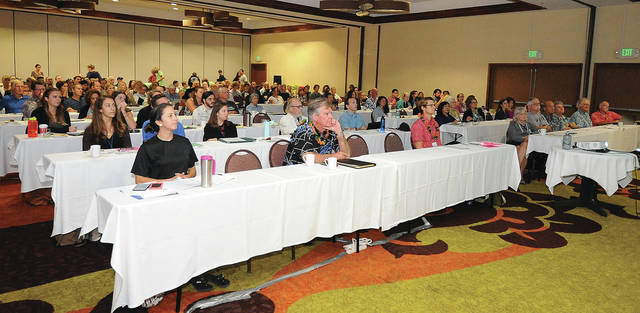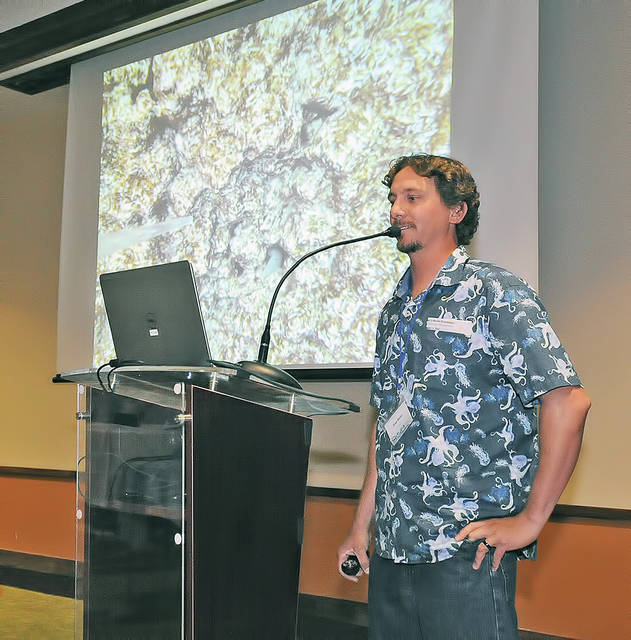KAILUA-KONA — Coral is still suffering in West Hawaii, though considerably less following three straight years of bleaching that decimated the entire coastline, claiming 50 percent of the area’s coral reefs.
The Hawaii state Division of Aquatic Resources (DAR), an arm of the Department of Land and Natural Resources, finalized data last Wednesday on 20 research sites throughout West Hawaii. The findings showed an average relative loss of coral cover of approximately 7 percent across the region, with absolute coral cover loss ranging between 1-5 percent at specific locations.
Lindsey Kramer delivered the news Tuesday morning at the “Symposium on West Hawaii’s Marine Ecosystem: Bridging the Gap Between Science and Management,” a conference hosted at the King Kamehameha’s Kona Beach Hotel by the West Hawaii Integrated Ecosystem Assessment Project, a National Oceanic Atmospheric Administration-funded program. It was the third symposium of its kind in West Hawaii, the other two coming in 2011 and 2014.
“We were really bummed,” Kramer said of the data.
She added, however, that no severe bleaching took place in the past year, just some partial bleaching of specific types of corals with which no mortality was associated.
While not ideal, Kramer said, contextually it’s a piece of good news considering the catastrophic impact of the bleaching event of 2015, as well as the considerable damage West Hawaii corals incurred during bleaching in 2014 and 2016.
“It was really horrific. There wasn’t a species that was immune to this,” Kramer said of the multi-year, worldwide bleaching event. “There weren’t a lot of regional patterns or differences in mortality. It was really widespread across the coastline.”
DAR has been able to identify trends over the last year, however, and not all of them are negative. Kramer explained that there was a “mixed bag” of coral recovery at seven monitored sites, while coral cover continued to decline at the other 13.
Regionally, coral did well in northern waters, where there was a relative coral cover increase of 2.7 percent.
Ross Martin — also an employee DAR, who provided numbers from a coral recruitment study running since 2004 and including nine sites up and down the coast — indicated those numbers are a reflection of higher recruitment rates in the waters off of North and South Kohala. He explained two likely reasons why.
“The northern part of the island is an older part of the island, and the reefs are much more broad,” Martin said. “Secondly, the general current comes from the south and pushes north, so a lot of the southern corals are probably seeding out to the north.”
He added that several southern reefs are healthy but likely struggled because they seed out to the north and are narrower than their northern counterparts.
Those factors were reflected in Kramer’s numbers, which indicated there was a 12 percent relative loss of coral cover in the southern region.
Kramer said there were some exceptions to the regional trends noted in DAR’s research. At Puako, situated in the northern zone, coral cover declined. In waters off of Old Kona Airport, located in a region that was characterized by general decline, coral cover increased.
Human activity and impact has proven strongest in the central zone of DAR’s long-time recruitment study, Martin said, which is one reason corals may have struggled there.
However, Kramer explained the region around Old Kona Airport is one of three monitored marine life conservation districts on the West Hawaii Coast. Two such districts saw coral cover increase in the last year, which she said is promising and warrants closer examination.
Other encouraging news included the type of algae replacing corals in certain areas. Crystal coralline algae (CCA) cover and light algal turf cover are both on the rise as coral replacements, which Kramer said is indicative of a potential for coral recovery.
Herbivores, or grazers, are vital algae removal agents that promote coral recovery. DAR research found the presence of two important grazers, urchins and parrotfish, were positively correlated with the presence of CCA and light algal turf, respectively.
Martin explained, though, that West Hawaii’s average recruitment rate over the DAR study — ongoing since 2004 — is 27. To put that in perspective, he contrasted it to other recruitment rates in the thousands.
He said the public can help aid in coral health and recovery by choosing protective clothing over sunscreen, as some chemicals present in most popular brands have proven detrimental to corals.
He added the public should do all it can to protect herbivores crucial to coral health and support marine protected areas, as they’ve proven “more resilient” to climate change and its impacts than non-protected waters.





